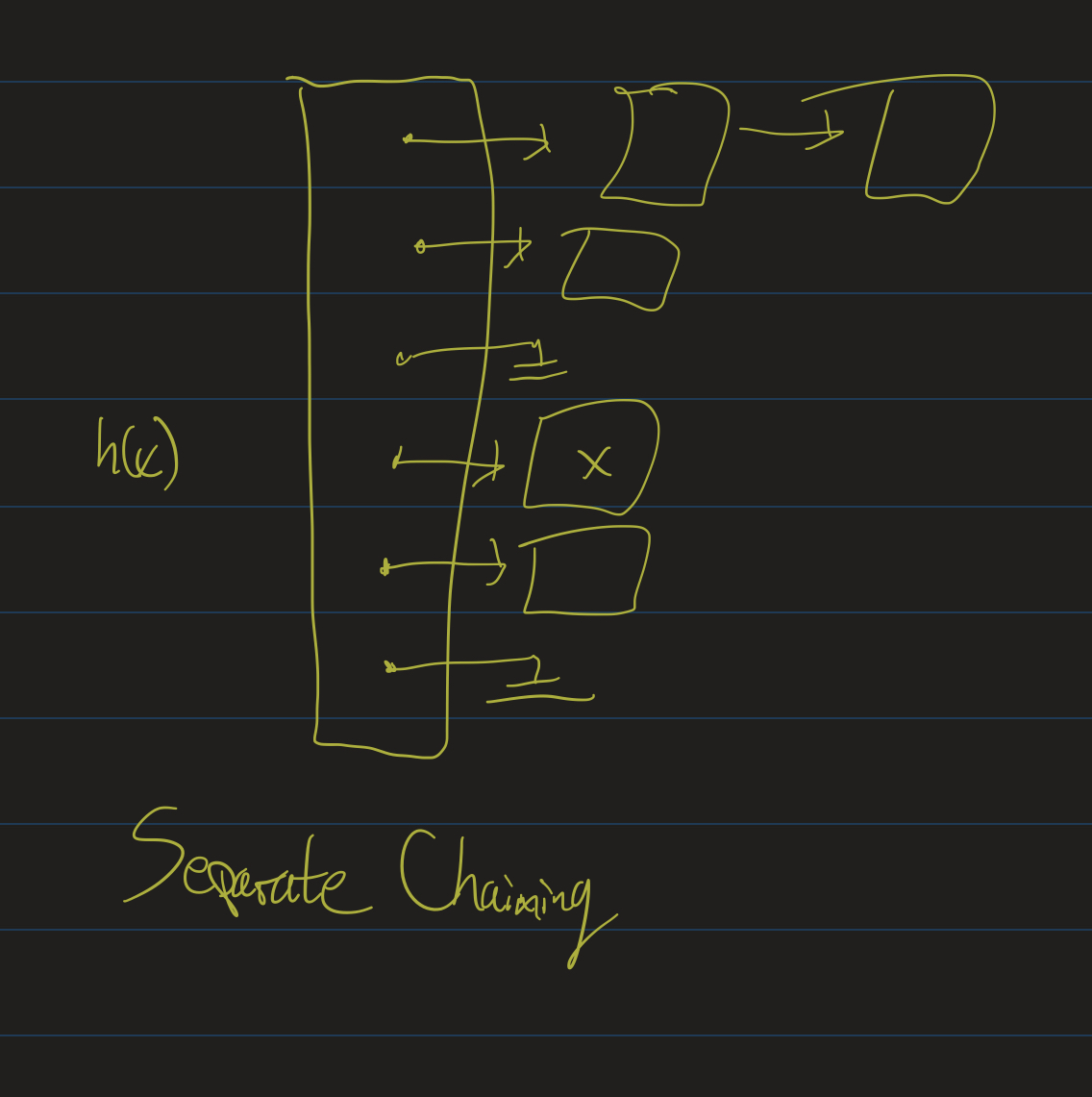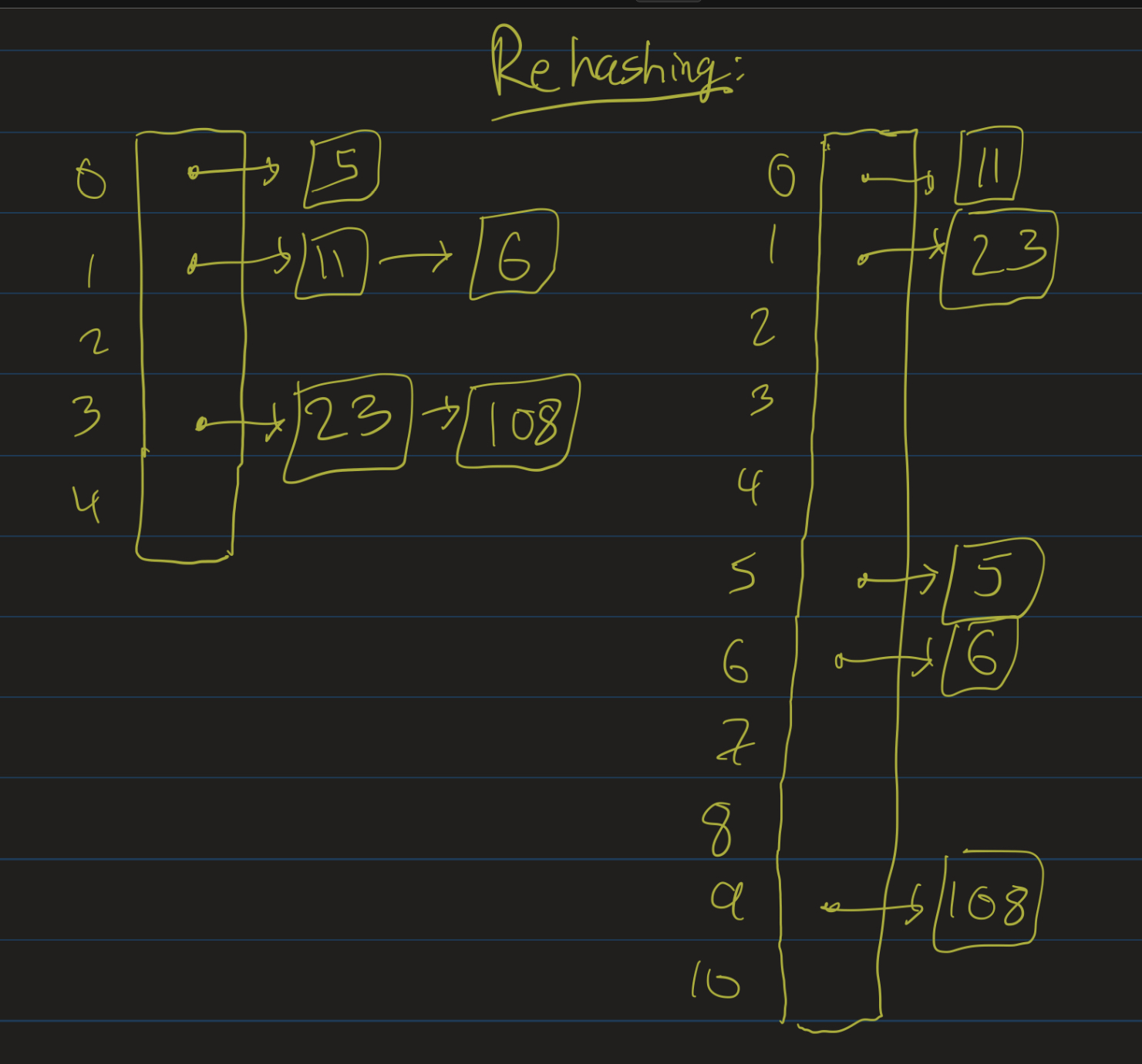Data Structures
Professor Abdul-Quader
Lesson 9 (Sets / Hashtable Intro)
Interview Question
The following question was posed to me on a phone interview.
Given a list of 2,000,000 unique 7-digit phone numbers, output them in order using no more than 4MB of additional memory.
Additional Context
Each integer requires 4 bytes of space. Can we store them all in memory? If not, how do we sort them if we can’t store all at once?
Discuss. Design your best solution. (5-10 minutes.)
Homework
Prove (by induction) that there are \(2^{h+1} - 1\) nodes in a complete binary tree of height \(h\), assuming the last level is completely filled.
Induction
To prove a statement for every number \(n\):
- Prove that the statement is true when \(n = 0\). (Base case)
- Prove that, for any natural number \(k\), if the statement is true when \(n = k\) (fixed), then the statement still holds for \(n = k + 1\). (Inductive step)
Base case: h = 0
- Prove that there are \(2^{1} - 1\) nodes in a complete binary tree of height \(0\), assuming the last level is completely filled.
- What is a tree of height 0?
Inductive step
- Suppose we know that, for some arbitrary \(h\), there are \(2^{h+1} - 1\) nodes in a complete binary tree of height \(h\), assuming the last level is completely filled.
- Consider a complete binary tree of height \(h + 1\). What does that look like?
- Has a root, which has two subtrees… of height?
- (Using inductive assumption) How many nodes in those subtrees?
- Therefore: how many nodes total?
- Conclusion: this tree has \(2^{h+2} - 1\) nodes.
Set ADT
A set is a gathering together into a whole of distinct objects of our thought – which are called elements of the set.
(Georg Cantor)
Mathematically, a set is a collection of distinct objects (no repetitions). Two sets are considered equal if they have the same elements.
Set operations
For our perspective, we consider the following operations on a set:
- contains
- insert
- remove
- size
Sometimes “insert” / “remove” are boolean methods, to indicate whether you were able to successfully modify the set (returning false, for example, if you tried to insert a duplicate).
Possible implementations
- ArrayList? Already has these operations. Running times? Can you get \(O(1)\) insert if you don’t allow duplicates?
- Tree?
- Generic type must implement Comparable
- Trees have contains / insert / remove.
- We can impelment a “size” easily, just keep track of it whenever we call insert or remove.
- Our implementation didn’t allow duplicates.
- Running times?
ArrayList implementation
Exercise: Using an ArrayList, implement the Set interface. Analyze the time complexity of contains / insert / remove.
Better Implementation?
- All we care about: is \(x\) in the set or not?
- Do we need to store elements in order?
- Focus on integers:
- Trade-off: use a huge amount of space.
- Can we make insert / remove / contains \(O(1)\)?
Hashing
- Keep a large array, called
table, size \(s\) - Given data of type \(T\), need a function \(f : T \to [0, s - 1]\)
- Should be easy to compute, called the hash function
Operating?
- Add a data item to the set?
- Compute \(f(item)\), insert item into
table[f(item)]
- Compute \(f(item)\), insert item into
- Check if item is in the set? Check
table[f(item)] == null - Remove?
Hashtables
- This is the idea behind a hashtable.
- Lots of analysis needs to be done
- How do we define a good hash function?
- What is the likelihood of a collision?
- What happens if there are collisions?
Video
Hash Functions
Suppose we have a large array of size \(s\).
- key: “lookup” value used as input to the hash function.
- hash function: a function which maps keys to a value between \(0\) and \(s - 1\).
- Outputs should be (roughly) uniformly distributed: the probability that, given a random key \(k\), \(h(k) = i\) should be the same for all \(i \in \{ 0, 1, \ldots, s - 1 \}\).
Example
- Example (integer keys): \(h(x) = x\) mod \(s\).
- In what scenarios would this be a good hash function?
- Bad?
- Choose a good table size \(s\) to avoid these problems?
String Keys
Simple idea: think of a word as a number in base 27 (“a” represents the digit 1, and “z” represents the digit 27), then convert it to an integer.
- “abc” hashes to \(27^2 \times 1 + 27 \times 2 + 3\).
- What do we do if this value ends up larger than the hashtable size?
- Any major problem with this approach? (Hint: what characters can make up a String?)
Let’s look at the built-in hash function for Strings in Java.
Video
Collisions
- Collision: when two objects hash to the same value (or same index in the array)
- Insert \(N\) items into a hashtable of size \(s\). Probability of collision?
The math here is a little bit of a challenge, let’s do some examples!
Probability
Insert \(N\) items into a table of size \(s\). Suppose the hash function is uniform. What’s the probability of a collision?
- \(N = 2, s = 4\)?
- Two elements: \(x\) and \(y\).
- Probability that \(h(x) == h(y)\)?
- Probability that \(h(x) \neq h(y)\) is 3/4, so probabiliyt of collision is \(1/4\).
N = 3, s = 9
- Three: \(x, y, z\). Probability that \(h(x) == h(y)\) or \(h(x) == h(z)\) or \(h(y) == h(z)\)?
- Maybe easier to solve: probability that \(h(x)\), \(h(y)\) and \(h(z)\) are all different!
- Probability of a collision then is \(1 - Prob(h(x), h(y), h(z)\) are different\()\).
N = 4, s = 9
- Same idea, first find the probability that all four hash values are different
- Then subtract from 1.
Birthday Problem
- \(N = 23\), \(s = 365\) is the famous birthday problem!
- In a room with 23 people, there is a greater than 50% chance that two of them have the same birthday!
- What does this have to do with hash collisions?
- What’s the “hash function” here?
- What are the “keys” here?
- In general, if \(N > \sqrt{s}\), there is a good chance of a collision.
Video
Collision Resolution
Two main strategies for collision resolution:
- Separate chaining: Each entry in the hashtable is a List or some other data structure (usually a LinkedList)
- Open addressing: search through the hashtable for another location to put something in.
Think about
As we learn about these, keep this question in mind: in what scenarios (in terms of the table size \(s\) and the number of insertions \(N\)) might we prefer one scheme over the other?
Load Factor
- Let \(N\) be number of elements to insert into the table.
- Let \(s\) be the size of the table.
- \(\lambda = \dfrac{N}{s}\) is called the load factor of the table.
- \(\lambda\) small: few collisions, lots of wasted space
- \(\lambda\) large: space used efficiently, but high chance of collisions.
Separate Chaining
- Don’t keep a “large array”.
- Instead: keep an array of \(s\) lists.
- Think of each list as a “bucket” (or “bin”).
- Elements that hash to the same value go in to the same bucket.
Image

Running times
- Insert \(x\): compute hashcode \(h(x)\), add \(x\) to the \(h(x)\)-th list.
- Running time of insert?
contains: compute the hash function, check the relevant list.- Running time (average case)? Worst case?
- What happens as \(\lambda\) increases?
- Can we keep a bound on \(\lambda\)?
Rehashing
- If we allow \(\lambda\) to increase without bound, performance degrades.
- Many implementations (including Java’s) will rehash if it increases too much.
- Increase the size of the table (usually: pick the next prime number \(p > 2s\)).
- Go through each previously inserted item, and re-insert into the new table.
- Should not happen too often, so that we still get (amortized) constant time inserts.
Image

Video
Upcoming
- Finish up on hashtables intro (separate chaining / open addressing) next time.
- Revisit some of the challenge problems from last week.
- Quiz 1 next week (Monday or Thursday, not sure yet); can make up anything incorrect / missed for homework.
- HW 2 due next week.
- Project 2 coming up.